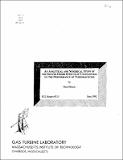An analytical and numerical study of the second-order effects of unsteadiness on the performance of turbomachines
Author(s)
Fritsch, Gerd
Download26621216.pdf (8.158Mb)
Other Contributors
Massachusetts Institute of Technology. Gas Turbine Laboratory
Metadata
Show full item recordAbstract
A linear approach in two dimensions is used to investigate the second-order effects of unsteadiness on the efficiency of turbomachines. The three main themes are the identification of physical nature and location of unsteady loss mechanisms, the magnitude of the associated losses and their effect on the time-mean efficiency, and the assessment of the modeling accuracy of numerical simulations with respect to unsteady loss. A mathematically rigorous link is established between linear waves in a compressible, two-dimensional flow and the efficiency drop associated with their dissipation. The analysis is applied to the mixing loss at the interface in a steady simulation of rotor/stator interaction in a turbine and to the study of unsteady loss mechanisms. Two unsteady loss mechanisms are considered. Unsteady Circulation Loss, i.e. the transfer of mean-flow energy to kinetic energy associated with vorticity shed at the trailing edge in response to an unsteady circulation, was first considered by Keller (1935) and later by Kemp and Sears (1955). Keller's original work is extended to compressible, homentropic flows. The use of simulations to obtain circulation amplitudes avoids the limitations of thin-airfoil theory and yields a loss measure realistic for modern turbomachines. For the Unsteady Viscous Loss mechanism, i.e. the dissipation induced by pressure waves in unsteady boundary layers, the high-reduced-frequency limit and a near-wall approximation are used to obtain the local velocity distribution in the laminar Stokes sublayer and the corresponding time-mean dissipation. The input to the model are the unsteady pressure gradients along a blade surface obtained from an unsteady simulation. A numerical study of the errors due to modeling approximation is included. Both sources of loss are small but not negligible. It is found that numerical smoothing shifts the principal locus of unsteady dissipation from boundary layers to the freestream, reducing the magnitude of the loss models input and the predicted loss.
Description
June 1992 Based on the author's Sc. D. thesis, Massachusetts Institute of Technology, Dept. of Aeronautics and Astronautics, 1992 Includes bibliographical references (pages 147-152)
Date issued
1992Publisher
Cambridge, Mass. : Gas Turbine Laboratory, Massachusetts Institute of Technology, [1992]
Series/Report no.
GTL report #210